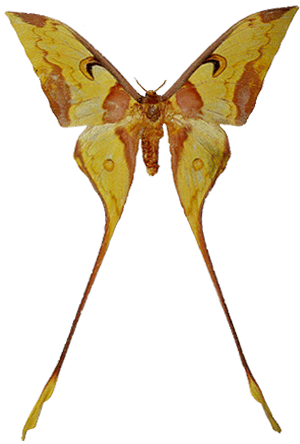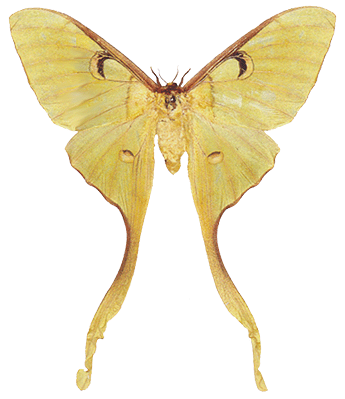|
Actias maenas Doubleday
Actias maenas Doubleday, 1847, Ann. Mag. nat. Hist., 19: 95.
Argema maenas Doubleday; Allen, 1981: 113; Barlow, 1982: 48.
Actias maenas Doubleday; Nassig & Peigler, 1984: 114; Lampe, 1985: 8.

Actias maenas 
(.65
natural size) |

Actias maenas 
(.65
natural size) |
Diagnosis. There is greater sexual dimorphism than in Actias
selena Hubner, the
narrower winged male having extensive rufous brown markings as illustrated.
Taxonomic notes. A number of taxa have been described either as subspecies of
maenas or as distinct species. They are listed under localities as follows:
|
S. Andamans:
|
Actias ignescens Moore, 1877, Proc. zool. Soc. Lond.,1877: 602.
|
|
Sumatra:
|
Sonthonnaxia recta Bouvier, 1928, Bull. Hill Mus.
Witley, 2: 138.
|
|
Sumatra/Java:
|
Sonthonnaxia
saja van Eecke, 1913, Notes Leyden Mus., 35: 134.
|
|
Java:
|
Saturnia leto Doubleday, 1848, Trans ent. Soc. Lond., 5:1.
|
|
Flores:
|
Actias maenas groenendaeli Roepke, 1954, Tijdschr. Ent.,
97: 257,
|
|
Sulawesi:
|
Argema
isis Sonthonnax, 1899, Essai classif. Lep. prod. Soie., 2: 14.
Argema latona Rothschild, 1901, Novit. zool., 8: 404.
Sonthonnaxia cotei
Testout, 1944, Bull. Soc. Linn. Lyon., 13: 147.
|
|
Amboina:
|
Tropaea
rosenbergii Kaup, 1895, Tropaea Fam. Saturn, Darmstadt & Leipzig:
Zernin.
Argema rieli Testout, 1942, Bull. Soc. Linn. Lyon., 11: 89.
|
Most
were placed as subspecies of maenas by Seitz (1926, Gross. Schmett,
Erde, 10:
500); the similarity of the male genitalia of Himalayan and Sulawesi specimens
indicate this is feasible, though the aedeagus and saccus in the latter are
distinctly shorter (W.A. Nassig, pers. comm).
Geographical range. Himalaya through South-east Asia to Sundaland, Sumba and
Flores, Sulawesi, Amboina.
Habitat
preference. The species has only been taken in lowland forest. It is infrequent.
Biology. A detailed account of the early stages has been published by Nassig
& Peigler (1984); a coloured illustration may be found in Gardiner (1982:
plate VIII). The mature larva is structured as in A. selene with strong pairs of
dorsal scoli and two smaller ones on each side; these are green or yellowish
rather than red; there is no strong lateral yellow stripe except in the third
instar. The skin has many small, white, seta-bearing granulations. The first
instar is orange with a broad black zone over the dorsum from A1 to A4. Pupation
is in a papery, irregularly ovoid cocoon, sparsely perforated, spun between
leaves.
Host-plants recorded in the wild are Averrhoa (Oxalidaceae), Schima,
Adinandra (Theaceae),
Turpina (Staphyleaceae) and Canarium (Burseraceae) but Nassig & Peigler
found the larvae would accept a variety of other plants in captivity.
<<Back
>>Forward <<Return
to Contents page
|

